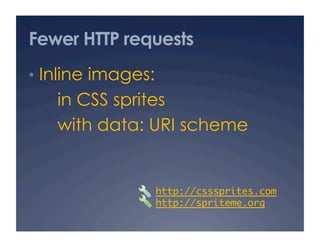Ad
Progressive Downloads and Rendering - take #2
- 1. Progressive downloads and rendering Stoyan Stefanov, Yahoo! HighLoad++, Moscow, 2010 http://slideshare.net/stoyan/
- 4. Importance of performance • Psychology, physiology • Effects of waiting • “Time is money” • Make people happy
- 5. Perception
- 6. Perception
- 7. Perception
- 8. Perception
- 11. Time is relative • Sometimes crawls • Sometimes flies • “it depends”
- 13. It feels slower when… • Unpleasant • Unknown • Boring • Too much to keep track
- 14. First time experience • Unfamiliar = slow • Optimize empty cache or there will be no full cache
- 16. But before we begin…
- 17. The basics • Reducing the # HTTP • Gzip • Minification • Image smushing • Expires • CDN
- 18. The basics • Yahoo!’s best practices + YSlow http://developer.yahoo.com/performance/ • Google’s too + Page Speed http://code.google.com/speed/
- 19. Progressive
- 24. Agenda 1. Prevent download blocks: scripts, styles, CC, favicon 2. Ways to render sooner: flush, data URIs, lazy loading, lazy evaluation, preloading, animations
- 27. JavaScript blocks • A no-no! <script src="jquery.js"></script> <script src="jquery.twitter.js"></script> <script src="jquery.cookie.js"></script> <script src="myapp.js"></script>
- 28. This waterfall looks ridiculous html js png png js js js
- 29. JavaScript at the bottom html js png png
- 30. Non-blocking JavaScript • defer and async • Defer: IE innovation, ok to delay, but keep order • Async: HTML5, whatever <script async src="my.js" onload="doIt()"></script> <script defer src="my.js" onload="doIt()"></script>
- 31. defer and async timeline DOMContentLoaded load async defer
- 32. Non-blocking JavaScript • Asynchronous loading var h, js = document.createElement('script'); js.src = 'myscript.js'; h = document.getElementsByTagName('head')[0]; h.appendChild(js); html js png png
- 33. Non-blocking JavaScript • Others: - iframe - XHR - <object> - …
- 35. Worst enemy? CSS
- 36. CSS blocks rendering • The worst component type • Place way at the top • @media print, etc in the same external CSS http://www.phpied.com/delay-loading-your-print-css/ http://www.phpied.com/rendering-styles/
- 37. CSS
- 38. CSS
- 39. CSS block downloads? But they do block: • When followed by an inline script • When in conditional comments
- 40. Inline CSS • Google search • Bing.com: inline + postload
- 41. Same domain • If you split across domains • and if you don’t use CDN • Saves a DNS lookup • e.g. Google and Bing’s CDN
- 42. CC block
- 43. Normal page
- 44. With conditionally commented CSS file http://www.phpied.com/ conditional-comments-block-downloads/
- 47. Solution for case #1 <!DOCTYPE html> <!‐‐[if IE 6]><![endif]‐‐> <html> ...
- 48. Solution for case #2 <!‐‐[if IE 6]> <html class="ie6"> <![endif]‐‐> <!‐‐[if !IE]><!‐‐> <html> <!‐‐<![endif]‐‐>
- 49. Blocking favicon
- 51. Flush
- 53. flush() <html> <head> <script src="my.js" type="text/javascript"></script> <link href="my.css" type="text/css" rel="stylesheet" /> </head> <body> .... <?php flush() ?>
- 55. Chunked encoding • Progressive rendering - Semantic app chunks vs. - Server-level chunks
- 57. <!doctype html> <html> <head><title>My App</title></head> <body> <div id="header"> <img src="logo.png" /> ... </div> <!-- end of chunk #1 --> ... The full body of the page ... <!-- end of chunk #2 --> <script src="all_20100925.js"></script> </body> </html> <!-- end of chunk #3 -->
- 58. Progressive + source order 1 2 3 4
- 59. HTTP chunking: not only HTML
- 60. HTTP chunking: not only HTML • Google Instant • /*""*/ - delimited JSON pieces • Chunk #1 suggestions • Chunk #2 results http://tinyurl.com/chunkview
- 61. Data URIs
- 62. Fewer HTTP requests • Inline images: in CSS sprites with data: URI scheme http://csssprites.com http://spriteme.org
- 63. Fewer HTTP requests • data: URI scheme $ php ‐r "echo base64_encode(file_get_contents('my.png'));” iVBORw0KGgoAAAANSUhEUgAAAAQAAAADCAIAAAA7ljmRAAAAGElEQVQIW2P4 DwcMDAxAfBvMAhEQMYgcACEHG8ELxtbPAAAAAElFTkSuQmCC
- 64. Fewer HTTP requests • data: URI scheme background‐image: url("data:image/png;base64,iVBORw0KG...");
- 65. Fewer HTTP requests • data: URI scheme <img src="data:image/png;base64,iVBOR..." />
- 68. Both • flushes • data: URIs
- 71. Fewer HTTP requests • data: URI scheme • works in IE!...
- 72. Fewer HTTP requests • data: URI scheme • works in IE8!
- 73. Fewer HTTP requests • data: URI scheme • MHTML for IE < 8
- 81. MHTML • MIME HTML • Works in IE 6,7 • Indeed it actually absolutely does work in IE7/Vista too http://phpied.com /the-proper-mhtml-syntax/
- 82. MHTML - one part Content-Location: myimage Content-Transfer-Encoding: base64 iVBORw0KGgoAAAANSU....U5ErkJggg==
- 83. MHTML - multi parts Content-Type: multipart/related; boundary="MYSEPARATOR" --MYSEPARATOR [here comes part one] --MYSEPARATOR [here's part two] --MYSEPARATOR-- The double- dash of doom
- 84. MHTML.css – all together /* Content-Type: multipart/related; boundary="MYSEPARATOR" --MYSEPARATOR Content-Location: myimage Content-Transfer-Encoding: base64 iVBORw0KGgoAAAANSUhEUgAAABgAAAAYCAMAAADXqc3KAAAD....U5ErkJggg== --MYSEPARATOR Content-Location: another Content-Transfer-Encoding: base64 iVBORw0KGgoAAAANSUhEUgAAABgAAAAYCAMAAADXqc3KAAAA....U5ErkJggg== --MYSEPARATOR-- */ .myclass { background-image:url(mhtml:http://example.org/styles.css!myimage); } .myotherclass { background-image:url(mhtml:http://example.org/styles.css!another); }
- 85. MHTML: inline too<!doctype html> <html> <head> <title>Look Ma' No HTTP requests</title> <style type="text/css"> /* Content-Type: multipart/related; boundary="_" --_ Content-Location:locoloco Content-Transfer-Encoding:base64 iVBOR...CC --_ Content-Location:polloloco Content-Transfer-Encoding:base64 iVBOR....gg== --_-- */ .image1 { background-image: url("data:image/png;base64,iVBOR...CC"); /* normal */ *background-image: url(mhtml:http://...html!locoloco); /* IE < 8 */ } .image2 { background-image: url("data:image/png;base64,iVBOR...gg=="); /* normal */ *background-image: url(mhtml:http://...html!polloloco); /* IE < 8 */ } body { font: bold 24px Arial; } </style> </head> <body> <h1>MHTML + Data:URIs inline in <code>style</code></h1> <p class="image1">hello<br>hello</p> <p class="image2">bonjour<br>bonjour</p> </body> </html> http://phpied.com /inline-mhtml-data-uris/
- 86. <!doctype html> <html> <head> <title>Look Ma' No HTTP requests</title> <style type="text/css"> ...
- 88. .image1 { background-image: url("data:image/png;base64,iVBOR...CC"); /* normal */ *background-image: url(mhtml:http://...html!locoloco); /* IE < 8 */ } .image2 { background-image: url("data:image/png;base64,iVBOR...gg=="); /* normal */ *background-image: url(mhtml:http://...html!polloloco); /* IE < 8 */ } body { font: bold 24px Arial; }
- 89. ... </style> </head> <body> <h1>MHTML + Data:URIs inline in <code>style</code></h1> <p class="image1">hello<br>hello</p> <p class="image2">bonjour<br>bonjour</p> </body> </html>
- 90. MHTML + data URI • X-browser single request web apps
- 91. Single request • WT☠? • Separation of concerns • Content-presentation- behavior • yes, it’s a tradeoff
- 92. MHTML + data URI • drawback: repeats the same encoded image • solutions: - browser-specific CSS - keep close = better gzip - or… an ingenious hack
- 93. Single stream MHTML/data URI • image header + css + data /9j/4AA0;background-image:url(data:image/jpeg;base64;00,/9j/4AA0 Reality: IE: Others: http://habrahabr.ru/blogs/webdev/90761/
- 94. /* Content-Type: multipart/related; boundary="granitza" --granitza Content-Type: text/css; */ #myid { /* --granitza Content-Location: myimage Content-Transfer-Encoding: base64 Content-Type: image/jpeg;*/ /9j/4AA0;background-image:url(data:image/jpeg;base64;00,/9j/4AAQSkZJRgA...); /* --granitza Content-Type: text/css; */ background-image: url(mhtml:http://localhost/my.css!myimage) !ie; } /* --granitza-- */
- 95. /* Content-Type: multipart/related; boundary="granitza" --granitza Content-Type: text/css; */ #myid { /* --granitza Content-Location: myimage Content-Transfer-Encoding: base64 Content-Type: image/jpeg;*/ /9j/4AA0;background-image:url(data:image/jpeg;base64;00,/9j/4AAQSkZJRgA...); /* --granitza Content-Type: text/css; */ background-image: url(mhtml:http://localhost/my.css!myimage) !ie; } /* --granitza-- */ ???
- 96. /* Content-Type: multipart/related; boundary="granitza" --granitza Content-Type: text/css; */ #myid { /* --granitza Content-Location: myimage Content-Transfer-Encoding: base64 Content-Type: image/jpeg;*/ /9j/4AA0;background-image:url(data:image/jpeg;base64;00,/9j/4AAQSkZJRgA...); /* --granitza Content-Type: text/css; */ background-image: url(mhtml:http://localhost/my.css!myimage) !ie; } /* --granitza-- */
- 97. /* Content-Type: multipart/related; boundary="granitza" --granitza Content-Type: text/css; */ #myid { /* --granitza Content-Location: myimage Content-Transfer-Encoding: base64 Content-Type: image/jpeg;*/ /9j/4AA0;background-image:url(data:image/jpeg;base64;00,/9j/4AAQSkZJRgA...); /* --granitza Content-Type: text/css; */ background-image: url(mhtml:http://localhost/my.css!myimage) !ie; } /* --granitza-- */ ???1 2 3
- 98. Single stream MHTML/data URI • And for <img> too!
- 99. Single stream <img> <h2>Hello Kitty</h2> <! --granitza Content-Location: myimage Content-Transfer-Encoding: base64 Content-Type: image/gif 2 invalid MHTML headers lines followed by data--><![if gt IE 7]> <img width="16" height="16" src="data:image/gif;base64, R0lGODl ... FxMKVvDijNQaodOl+N5Pk+pmIX7brGweCg4SCEhEAOw=="><![endif]> <!--[if lt IE 8]> <img src="mhtml:http://.../bolknote.html!myimage" width="16" height="16"> <![endif]--> <p> more page... </p>
- 100. Single stream <img> <h2>Hello Kitty</h2> <! --granitza Content-Location: myimage Content-Transfer-Encoding: base64 Content-Type: image/gif 2 invalid MHTML headers lines followed by data--><![if gt IE 7]> <img width="16" height="16" src="data:image/gif;base64, R0lGODl ... FxMKVvDijNQaodOl+N5Pk+pmIX7brGweCg4SCEhEAOw=="><![endif]> <!--[if lt IE 8]> <img src="mhtml:http://.../bolknote.html!myimage" width="16" height="16"> <![endif]--> <p> more page... </p>
- 101. Lazy loading
- 102. Lazy loading aka post-loading • After-onload • Some images • Below the fold (on scroll) • Hidden content e.g. tabs
- 105. Amazon’s lazy bestsellers • Page’s purpose is ranking • Details can come later • via onload XHR • JS off = no details • but that’s fine (see bullet #1)
- 106. Lazy evaluation
- 107. GMail mobile’s lazy JS <!doctype html> <html><body> ... <script id="lazy">/* console.log("I can wait"); */</script> ... <script> console.log("I'm needed"); window.onload = function () { var comment = document.getElementById('lazy') .innerHTML, code = comment.substring(3, comment.length - 3); eval(code); }; </script> </body></html> http://googlecode.blogspot.com/2009/09 /gmail-for-mobile-html5-series-reducing.html
- 109. Lazy HTML <!doctype html> <html><body> ... <div id="lazy"><!-- <p>lots of html goes here...</p> --></div> ... <script> window.onload = function () { var el = document.getElementById('lazy'), inner = el.innerHTML, code = inner.substring(4, inner.length - 3); el.innerHTML = code; }; </script> </body></html> http://phpied.com... (coming-soon)
- 110. Lazy HTML test • 500K (200K gzipped) HTML doc • “Sherlock Holmes” • comment out 95% • still one whole chapter left http://www.phpied.com/files/lazyhtml/start.html
- 111. Lazy HTML test results
- 112. Lazy HTML - misc • Who loads a book? • Use case: blog comments • SEO? Content is hidden • What about display: none? • The test page was simple-to- render, no complex layout
- 113. Preloads
- 114. Preloads • Anticipate next page • Problems: - does next page anticipate you? - parsing and execution time • <link prefetch="http://..">
- 115. Preload sans execute var preload; if (/*@cc_on!@*/false) { // IE preload = function (file) { new Image().src = file; }; } else { preload = function (file) { var obj = document.createElement('object'), body = document.body; obj.width = 0; obj.height = 0; obj.data = file; body.appendChild(obj); }; }
- 116. Preload, then execute var loader = function (file, callback) { var obj = document.createElement('object'), body = document.body; obj.width = 0; obj.height = 0; obj.data = file; obj.onload = function () { var h, js = document.createElement('script'); js.src = file; js.onload = callback; h = document.getElementsByTagName('head')[0]; h.appendChild(js); }; body.appendChild(obj); };
- 118. Chrome search • In-browser search box • Gives suggestions as you type • Visual suggestions in IE8+
- 119. IE8 Visual Search Suggestions ... <Item> <Text>Currently: Partly Cloudy, 67F</Text> <Description>High: 71F Low: 63F</Description> <Url>http://weather.yahoo.com/forecast/ USCA1024_f.html</Url> <Image source="http://l.yimg.com/a/i/us/we/31/30.gif" alt="Partly Cloudy" width="31" height="31"/> </Item> ...
- 120. IE8 Visual Search Preload ... <Item> <Text>any search suggestion</Text> <Image source="http://path/to/sprite.png" width="0" height="0"/> </Item> ...
- 121. IE8 Visual Search Preload
- 122. IE8 Visual Search Preload • didn’t work for CSS and JS
- 123. IE8 Visual Search • preload images, e.g. sprite • DNS lookups via beacons
- 125. Distractimations
- 126. Parting words
- 127. What not to say… • “Everyone is on high-speed these days” • “It’s all in the cache”
- 128. Do care about • Progressive, non-blocking, asynchronous downloads • Progressive rendering
- 129. Thank you! Stoyan Stefanov @stoyanstefanov http://www.phpied.com Slides: http://slideshare.net/stoyan/
































![Non-blocking JavaScript
• Asynchronous loading
var h, js = document.createElement('script');
js.src = 'myscript.js';
h = document.getElementsByTagName('head')[0];
h.appendChild(js);
html
js
png
png](https://image.slidesharecdn.com/progress-all-101025014604-phpapp02/85/Progressive-Downloads-and-Rendering-take-2-32-320.jpg)












![What…?! Case #1
<link type="text/css" rel="stylesheet"
href="1.css">
<!‐‐[if IE 6]>
<link type="text/css" rel="stylesheet"
href="ie.css">
<![endif]‐‐>](https://image.slidesharecdn.com/progress-all-101025014604-phpapp02/85/Progressive-Downloads-and-Rendering-take-2-45-320.jpg)
![What…?! Case #2
<!‐‐[if IE 6]>
<body class="ie6">
<![endif]‐‐>
<!‐‐[if !IE]><!‐‐>
<body>
<!‐‐<![endif]‐‐>](https://image.slidesharecdn.com/progress-all-101025014604-phpapp02/85/Progressive-Downloads-and-Rendering-take-2-46-320.jpg)
![Solution for case #1
<!DOCTYPE html>
<!‐‐[if IE 6]><![endif]‐‐>
<html>
...](https://image.slidesharecdn.com/progress-all-101025014604-phpapp02/85/Progressive-Downloads-and-Rendering-take-2-47-320.jpg)
![Solution for case #2
<!‐‐[if IE 6]>
<html class="ie6">
<![endif]‐‐>
<!‐‐[if !IE]><!‐‐>
<html>
<!‐‐<![endif]‐‐>](https://image.slidesharecdn.com/progress-all-101025014604-phpapp02/85/Progressive-Downloads-and-Rendering-take-2-48-320.jpg)


































![MHTML - multi parts
Content-Type: multipart/related; boundary="MYSEPARATOR"
--MYSEPARATOR
[here comes part one]
--MYSEPARATOR
[here's part two]
--MYSEPARATOR--
The
double-
dash of
doom](https://image.slidesharecdn.com/progress-all-101025014604-phpapp02/85/Progressive-Downloads-and-Rendering-take-2-83-320.jpg)















![Single stream <img>
<h2>Hello Kitty</h2>
<!
--granitza
Content-Location: myimage
Content-Transfer-Encoding: base64
Content-Type: image/gif
2 invalid MHTML headers lines followed by data--><![if gt IE 7]>
<img width="16" height="16" src="data:image/gif;base64,
R0lGODl ... FxMKVvDijNQaodOl+N5Pk+pmIX7brGweCg4SCEhEAOw=="><![endif]>
<!--[if lt IE 8]>
<img src="mhtml:http://.../bolknote.html!myimage" width="16"
height="16">
<![endif]-->
<p> more page... </p>](https://image.slidesharecdn.com/progress-all-101025014604-phpapp02/85/Progressive-Downloads-and-Rendering-take-2-99-320.jpg)
![Single stream <img>
<h2>Hello Kitty</h2>
<!
--granitza
Content-Location: myimage
Content-Transfer-Encoding: base64
Content-Type: image/gif
2 invalid MHTML headers lines followed by data--><![if gt IE 7]>
<img width="16" height="16" src="data:image/gif;base64,
R0lGODl ... FxMKVvDijNQaodOl+N5Pk+pmIX7brGweCg4SCEhEAOw=="><![endif]>
<!--[if lt IE 8]>
<img src="mhtml:http://.../bolknote.html!myimage" width="16"
height="16">
<![endif]-->
<p> more page... </p>](https://image.slidesharecdn.com/progress-all-101025014604-phpapp02/85/Progressive-Downloads-and-Rendering-take-2-100-320.jpg)















![Preload, then execute
var loader = function (file, callback) {
var obj = document.createElement('object'),
body = document.body;
obj.width = 0;
obj.height = 0;
obj.data = file;
obj.onload = function () {
var h, js = document.createElement('script');
js.src = file;
js.onload = callback;
h = document.getElementsByTagName('head')[0];
h.appendChild(js);
};
body.appendChild(obj);
};](https://image.slidesharecdn.com/progress-all-101025014604-phpapp02/85/Progressive-Downloads-and-Rendering-take-2-116-320.jpg)





















































![[O'Reilly] HTML5 Design](https://cdn.slidesharecdn.com/ss_thumbnails/html5-workshop-111215160913-phpapp01-thumbnail.jpg?width=560&fit=bounds)




![[In Control 2010] HTML5](https://cdn.slidesharecdn.com/ss_thumbnails/incontrolorlandohtml5-100302003930-phpapp01-thumbnail.jpg?width=560&fit=bounds)




































![Download Chimera Tool Setup V42.47.0924 [Latest Version]](https://cdn.slidesharecdn.com/ss_thumbnails/artificialintelligence4-250505221011-8e660a4e-thumbnail.jpg?width=560&fit=bounds)



